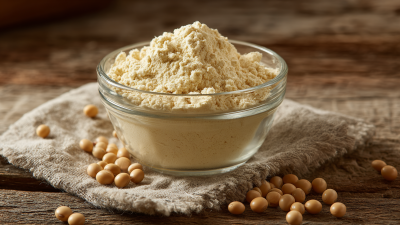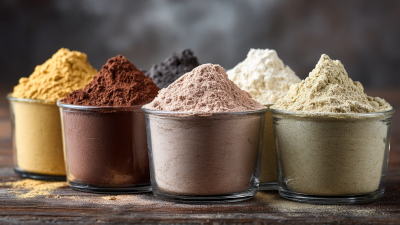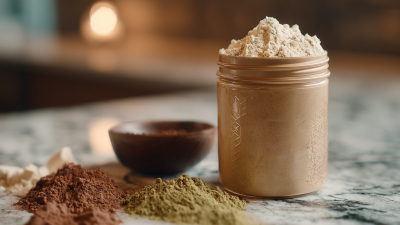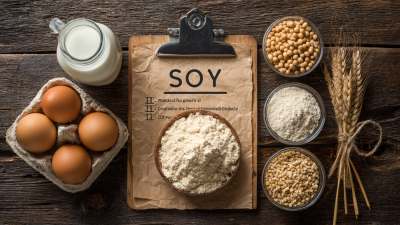As plant-based diets continue to surge in popularity, the demand for high-quality protein alternatives has never been greater. Textured Soy Protein (TSP) stands at the forefront of this evolution, providing an innovative solution that meets both nutritional needs and culinary versatility. According to the Good Food Institute, the plant-based protein market is projected to reach $27.9 billion by 2025, driven by increasing consumer awareness of health, sustainability, and ethical eating. TSP, derived from soybeans, offers a complete amino acid profile, making it an excellent source of protein for vegetarians and vegans alike. The versatility of TSP allows it to be used in a multitude of dishes, from burgers to sauces, catering to a wide range of palates. Furthermore, a report from ResearchAndMarkets reveals that plant protein consumption could save the global economy an estimated $1.86 trillion in healthcare costs by 2030. With such remarkable benefits, Textured Soy Protein is undeniably a game-changer in the realm of plant-based diets.

 Textured soy protein (TSP) has emerged as a powerhouse ingredient in plant-based diets, offering an array of nutritional advantages that cater to the needs of health-conscious consumers. High in protein, TSP provides a complete amino acid profile, making it an excellent meat substitute for those looking to reduce their animal protein intake. This is particularly beneficial for individuals following vegetarian or vegan diets, as it helps meet their daily protein requirements without compromising on nutrition.
Textured soy protein (TSP) has emerged as a powerhouse ingredient in plant-based diets, offering an array of nutritional advantages that cater to the needs of health-conscious consumers. High in protein, TSP provides a complete amino acid profile, making it an excellent meat substitute for those looking to reduce their animal protein intake. This is particularly beneficial for individuals following vegetarian or vegan diets, as it helps meet their daily protein requirements without compromising on nutrition.
Additionally, TSP is rich in fiber, promoting digestive health and aiding in weight management. Its fiber content not only contributes to a feeling of fullness, making it easier for individuals to control their appetite, but also supports a healthy gut microbiome. Moreover, textured soy protein is low in fat and contains no cholesterol, making it a heart-healthy option that aligns with the dietary goals of many health enthusiasts. As more people adopt plant-based diets, incorporating TSP can significantly enhance their meals, delivering both substantial health benefits and an enjoyable texture in various dishes.
Textured soy protein (TSP) has emerged as a versatile ingredient that enhances the variety and flavor profiles of plant-based diets. According to a report by Grand View Research, the global textured vegetable protein market is expected to reach $3.85 billion by 2025, indicating a growing demand for ingredients that not only provide protein but also contribute to the culinary experience.
TSP's ability to mimic the texture of meat makes it an excellent substitute in diverse dishes, from tacos to stir-fries, allowing individuals to explore a wide range of flavors without compromising on protein intake.
Moreover, its adaptability in various cuisines plays a crucial role in meal preparation. Research conducted by the Pea Protein Association found that incorporating TSP into meals can lead to a 15-20% increase in protein content, catering to the nutritional needs of consumers seeking plant-based options. Chefs and home cooks alike appreciate TSP for its ability to absorb flavors from marinades and spices, thus enhancing the overall taste of dishes. This unique characteristic not only promotes a satisfying eating experience but also encourages creativity in the kitchen, making TSP a game-changer for those embracing plant-based diets.
Textured soy protein (TSP) has emerged as a vital solution for addressing protein deficiencies, particularly in plant-based diets. With global protein consumption rising and an increasing number of individuals shifting towards vegetarianism or veganism, the need for high-quality protein alternatives has never been more critical. According to a report from the United Nations Food and Agriculture Organization, approximately 800 million people worldwide suffer from protein deficiency. TSP, derived from soybeans, offers a complete protein profile that includes all essential amino acids, making it an excellent substitute for meat in various dishes.
Moreover, textured soy protein is not only rich in protein—providing about 50 grams of protein per 100 grams—but also low in fat and cholesterol-free. A study published in the "Journal of Nutritional Science" highlighted that incorporating TSP into diets could significantly improve protein intake among individuals, particularly in vulnerable populations such as children and the elderly. Its versatility allows it to be easily integrated into various recipes, making it a practical solution for those seeking to enhance their protein consumption without animal products. With the increasing awareness of plant-based nutrition, TSP stands out as a game-changer, providing essential nutrients while promoting sustainable eating habits.
 Textured soy protein (TSP) is gaining recognition as a sustainable alternative in plant-based diets, appealing especially to eco-conscious consumers. According to the World Resources Institute, plant-based diets can reduce greenhouse gas emissions by up to 70% compared to typical meat-based diets. This makes TSP not only a source of high-quality protein but also an environmentally friendly option that supports a more sustainable food system.
Textured soy protein (TSP) is gaining recognition as a sustainable alternative in plant-based diets, appealing especially to eco-conscious consumers. According to the World Resources Institute, plant-based diets can reduce greenhouse gas emissions by up to 70% compared to typical meat-based diets. This makes TSP not only a source of high-quality protein but also an environmentally friendly option that supports a more sustainable food system.
Moreover, the global demand for plant-based proteins is on the rise, with a projected market growth of $27.9 billion by 2025, as reported by Markets and Markets. This surge can be attributed to the growing awareness of climate change and health benefits associated with plant-based eating. TSP offers an excellent source of protein, containing all essential amino acids while being relatively low in fat and devoid of cholesterol, making it a nutritious choice for those seeking to reduce their ecological footprint. By choosing textured soy protein, consumers are not just making a health-conscious decision; they are actively participating in a shift towards sustainable food practices that benefit the planet.
Textured soy protein (TSP) is increasingly becoming a staple in plant-based diets, not just for its nutritional benefits but also for its versatility in cooking. With a chewy texture reminiscent of meat, it can be easily incorporated into a variety of dishes, making it an excellent alternative for those looking to reduce animal protein in their diets. From stir-fries to soups, TSP can absorb flavors and spices, enhancing any meal’s taste.
For everyday cooking, one simple recipe is TSP tacos. To prepare, rehydrate the textured soy protein in warm water or vegetable broth, then sauté with onions, garlic, and your choice of spices such as cumin and chili powder. Serve in corn tortillas topped with fresh avocado and salsa for a delicious, protein-packed meal. Another quick dish is TSP stir-fry; just stir-fry the hydrated TSP with seasonal vegetables and a soy sauce or teriyaki glaze for a vibrant, nutritious dinner option. These easy recipes make textured soy protein an accessible and tasty choice for anyone looking to embrace a plant-based lifestyle.






